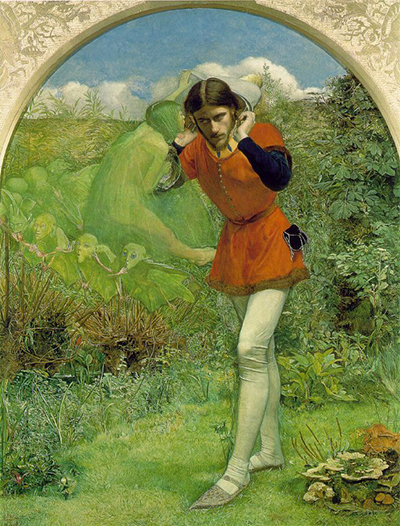Ferdinand Lured by Ariel, a painting that represents a specific episode from the first Act, Scene two of Shakespeare’s famous play The Tempest, was executed by John Everett Millais.
The painting depicts Ferdinand’s lines. Ferdinand Lured by Ariel depicts a young man listening to the Arial singing a lyric famously known as the full fathom five father lies. The Arial is tipping the hat Ferdinand is wearing from his head and holding on to its string. It clearly shows Ferdinand straining to hear his song. He looks direct at Arial; however, the latter is not visible to him. Ferdinand Lured by Ariel was the John Everett’s first trial at the famous plain air Pre-Raphaelite Brotherhood technique and style which he also did at the Shotover Park, Oxford. After the completion of this painting, Millais wrote to his friend as well as the Pre-Raphaelite member, Holman Hunt that he had designed and painted a ridiculous and elaborate landscape.
In this painting, John Everett Millais used the Pre-Raphael Brotherhood technique of painting. He utilised the technique to paint the entire face of Ferdinand, but he was influenced by the art of Frederic George Stephens who was familiar with a different Pre-Raphaelite style of painting. Both the pose and the clothing in this painting were derived from the plate six of Costumes Historiques which was Camille Bonnard’s art, and it depicts a costume of an Italian man.
The supernatural green bats that are available in the painting were among the last additions to the current composition. Their incongruous posture help put off the patron who has initially undertaken to purchase it. The images in the painting adopt the poses of speak, hear and see no evil. The invisible of the Arial, as well as the bats, is suggested by the semi-merger with the available green background. Also, the natural connection with the camouflage was influenced by this technique of painting, and it is implied by the availability of green lizards that are hiding in front of the clump in the right-hand foreground.
The painting was commissioned and bought by the famous collector Richard Ellison. It later entered Roger Makins’s collection, first Baron Sheffield who made the acquisition of various John Everett Millais's paintings. The medium and support that were used in Ferdinand Lured by Ariel include the oil on board and it was completed in 1849.




